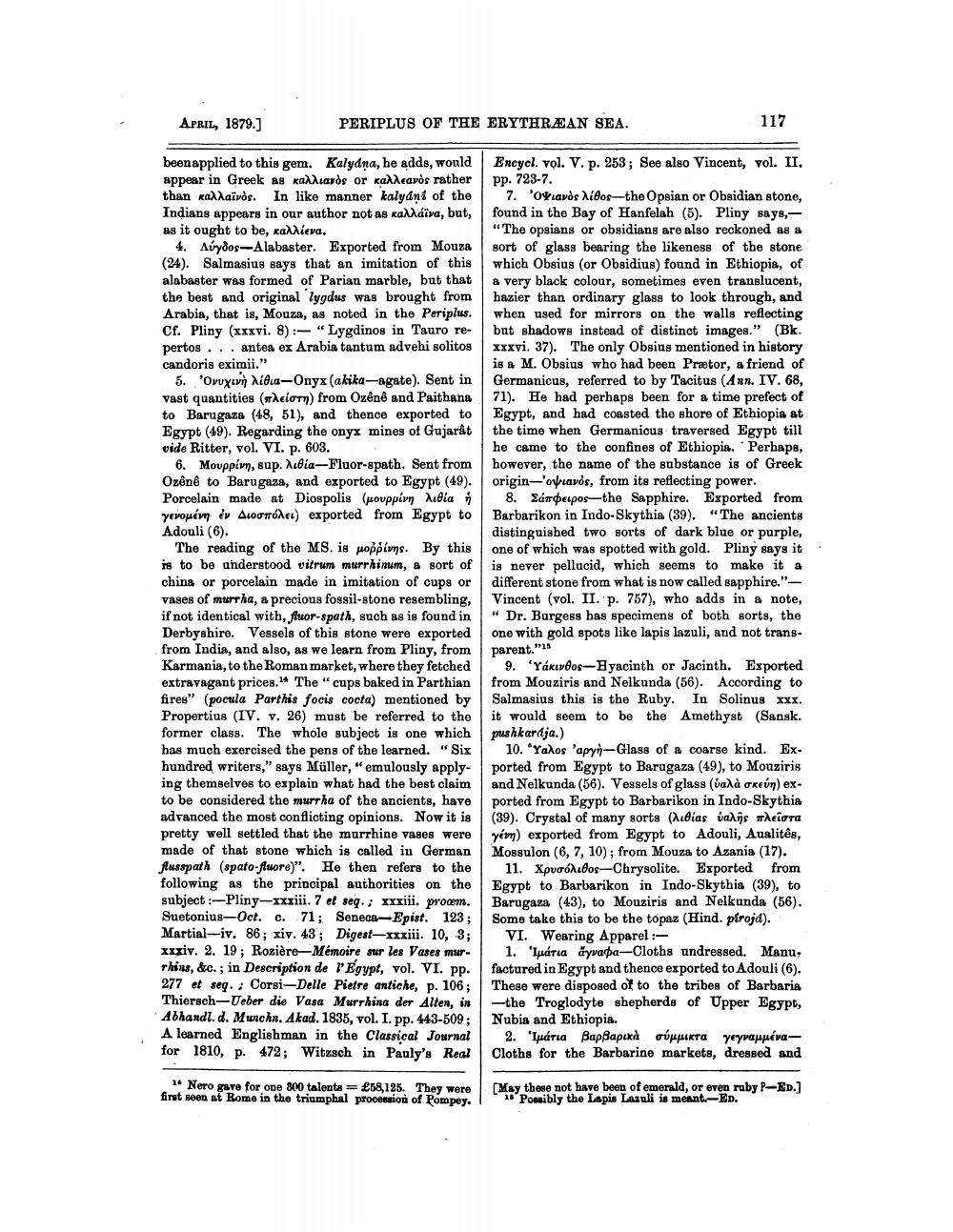________________
APRIL, 1879.]
PERIPLUS OF THE ERYTHRAAN SEA.
117
been applied to this gem. Kalydna, he adds, would appear in Greek 88 καλλιανός Οr καλλεανός rather than kallaïvòs. In like manner kalyani of the Indians appears in our author not as kalláïva, but, as it ought to be, kallieva.
4. Aúydos-Alabaster. Exported from Mouza (24). Salmasius says that an imitation of this alabaster was formed of Parian marble, but that the best and original lygdus was brought from Arabia, that is, Mouza, as noted in the Periplus. Cf. Pliny (xxxvi. 8):- "Lygdinos in Tauro repertos ... antea ex Arabia tantum advehi solitog candoris eximii."
5. 'OvuxLvn) Miba-Onyx (akika-agate). Sent in vast quantities (welotn) from Ozênê and Paithana to Barugaza (48, 51), and thence exported to Egypt (49). Regarding the onyx mines of Gujarat vide Ritter, vol. VI. p. 603.
6. Mouppivn, sup. Audia-Fluor-spath. Sent from Ozêng to Barugaza, and exported to Egypt (49). Porcelain made at Diospolis (μουρρίνη λιθία ή yevouém év AlocTÓL) exported from Egypt to Adouli (6).
The reading of the MS. is uoppims. By this is to be understood vitrum murrhinum, a sort of china or porcelain made in imitation of cups or vases of martha, a precious fossil-stone resembling, if not identical with, fluor-spath, such as is found in Derbyshire. Vessels of this stone were exported from India, and also, as we learn from Pliny, from Karmania, to the Roman market, where they fetched extravagant prices. The "cups baked in Parthian fires" (pocula Parthis focis cocta) mentioned by Propertius (IV. v. 26) must be referred to the former class. The whole subject is one which has much exercised the pens of the learned. "Six hundred writers," says Müller, "emulously apply- ing themselves to explain what had the best claim to be considered the murrha of the ancients, have advanced the most conflicting opinions. Now it is pretty well settled that the murrhine vases were made of that stone which is called in German flusspath (spato-fluore)". He then refers to the following as the principal authorities on the subject :-Pliny-xxxiii. 7 et seq. , xxxiii. procem. Suetonius-Oct. c. 71; Seneca-Epist. 123; Martial-iv. 86; xiv. 43; Digest-xxxiii. 10, 3; xxxiv. 2. 19; Rozière-Mémoire sur les Vases murThins, &c.; in Description de l'Egypt, vol. VI. pp. 277 et seq. ; Corsi - Delle Pietre antiche, p. 106; Thiersch-Ueber die Vasa Murrhina der Alten, in Abhandl. d. Munchn. Akad. 1835, vol. I. pp. 443-509; A learned Englishman in the Classical Journal for 1810, p. 472; Witzsch in Pauly's Real
Encycl. vol. V. p. 253; See also Vincent, vol. II, pp. 723-7.
7. 'Omavos Nidos--the Opsian or Obsidian stone, found in the Bay of Hanfelah (5). Pliny says,"The opsians or obsidians are also reckoned as a sort of glass bearing the likeness of the stone which Obsius (or Obsidius) found in Ethiopia, of a very black colour, sometimes even translucent, hazier than ordinary glass to look through, and when used for mirrors on the walls reflecting but shadows instead of distinct images." (Bk. xxxvi. 37). The only Obsias mentioned in history is a M. Obsius who had been Prætor, a friend of Germanicus, referred to by Tacitus (Ann. IV. 68, 71). He had perhaps been for a time prefect of Egypt, and had coasted the shore of Ethiopia at the time when Germanicus traversed Egypt till he came to the confines of Ethiopia. Perhaps, however, the name of the substance is of Greek origin-'opravos, from its reflecting power.
8. Sampelpos—the Sapphire. Exported from Barbarikon in Indo-Skythia (39). "The ancients distinguished two sorts of dark blue or purple, one of which was spotted with gold. Pliny says it. is never pellucid, which seems to make it a different stone from what is now called sapphire."Vincent (vol. II. p. 757), who adds in a note, “ Dr. Burgess has specimens of both sorts, the one with gold spots like lapis lazuli, and not trans
parent."25
9. 'Yakubos-Hyacinth or Jacinth. Exported from Mouziris and Nelkunda (56). According to Salmasius this is the Ruby. In Solinus xxx. it would seem to be the Amethyst (Sansk. pushkardja.)
10. 'Yalos 'apyn-Glass of a coarse kind. Exported from Egypt to Baragaza (49), to Mouziris and Nelkunda (56). Vessels of glass (úalà okeun) exported from Egypt to Barbarikon in Indo-Skythia (39). Crystal of many sorts (Acdias valis ciora yern) exported from Egypt to Adouli, Aualitês, Mossulon (6, 7, 10); from Mouza to Azania (17).
11. Xpuorodos—Chrysolite. Exported from Egypt to Barbarikon in Indo-Skythia (39), to Barugaza (43), to Mouziris and Nelkunda (56). Some take this to be the topaz (Hind. pirojd).
VI. Wearing Apparel :
1. 'Inária ãyvapa-Cloths undressed. Manu, factured in Egypt and thence exported to Adouli (6). These were disposed of to the tribes of Barbaria -the Troglodyte shepherds of Upper Egypt, Nubia and Ethiopia.
2. Ιμάτια βαρβαρικά σύμμικτα γεγναμμέναCloths for the Barbarine markets, dressed and
"Nero gave for one 300 talenta £58,125. They were first seen at Rome in the triumphal procession of Pompey,
[May these not have been of emerald, or even ruby P-BD.]
15 Posibly the Lapis Lazuli is meant.-ED.




